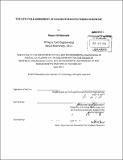The life cycle assessment of concrete manufacturing in Kuwait
Author(s)
El Mostafa, Mayce (Mayce A.)
DownloadFull printable version (17.52Mb)
Alternative title
Life cycle assessment of concrete manufacturing in Kuwait : a strive for a greener environment
Other Contributors
Massachusetts Institute of Technology. Department of Civil and Environmental Engineering.
Advisor
John Ochsendorf.
Terms of use
Metadata
Show full item recordAbstract
Concrete is the second most widely used material in the world after water. Annually 9,120 million tons of concrete are produced, which is an equivalent of 1.3 tons of concrete per individual. As the world's primary construction material, significant research regarding the strength and durability of concrete has been performed over the years. Recent research, however, is shifting towards the exploration of the sustainability of concrete and its contribution to global greenhouse gas emissions. The recent increase of construction projects in Kuwait in combination with the desire of decreasing fuel usage has led the Kuwait government and people to shift their attention towards the environment and its impacts. Life Cycle Assessment (LCA) is developed to assist in the quantification of the environmental impacts of specific products or services. This thesis focuses on the life cycle assessment of concrete manufacturing in Kuwait. The study is based on a range of concrete mixes and follows the standard protocols of the ISO 14040 and the United Nations Environment Program (UNEP). The LCA concentrates on the embodied energy of the concrete material and does not consider the utilization phases. The impact assessment of the LCA is based on the global warming potential, mainly the equivalent carbon dioxide emissions of the concrete mixture. The manufacturing of concrete in Kuwait is estimated to generate 470-530 kg of CO₂ per cubic meter of concrete; which is considered high when compared to concrete CO₂ emissions in the US, Sweden and Italy. The final outcome demonstrates that the variable that contributes the most to the environmental impact of concrete in Kuwait is the energy used in the production of cement and water desalination. Possible solutions for reduction of environmental impacts are the use of renewable resources and the recycling of aggregates.
Description
Thesis (M. Eng.)--Massachusetts Institute of Technology, Dept. of Civil and Environmental Engineering, 2013. Cataloged from PDF version of thesis. Includes bibliographical references (p. 67-70).
Date issued
2013Department
Massachusetts Institute of Technology. Department of Civil and Environmental EngineeringPublisher
Massachusetts Institute of Technology
Keywords
Civil and Environmental Engineering.